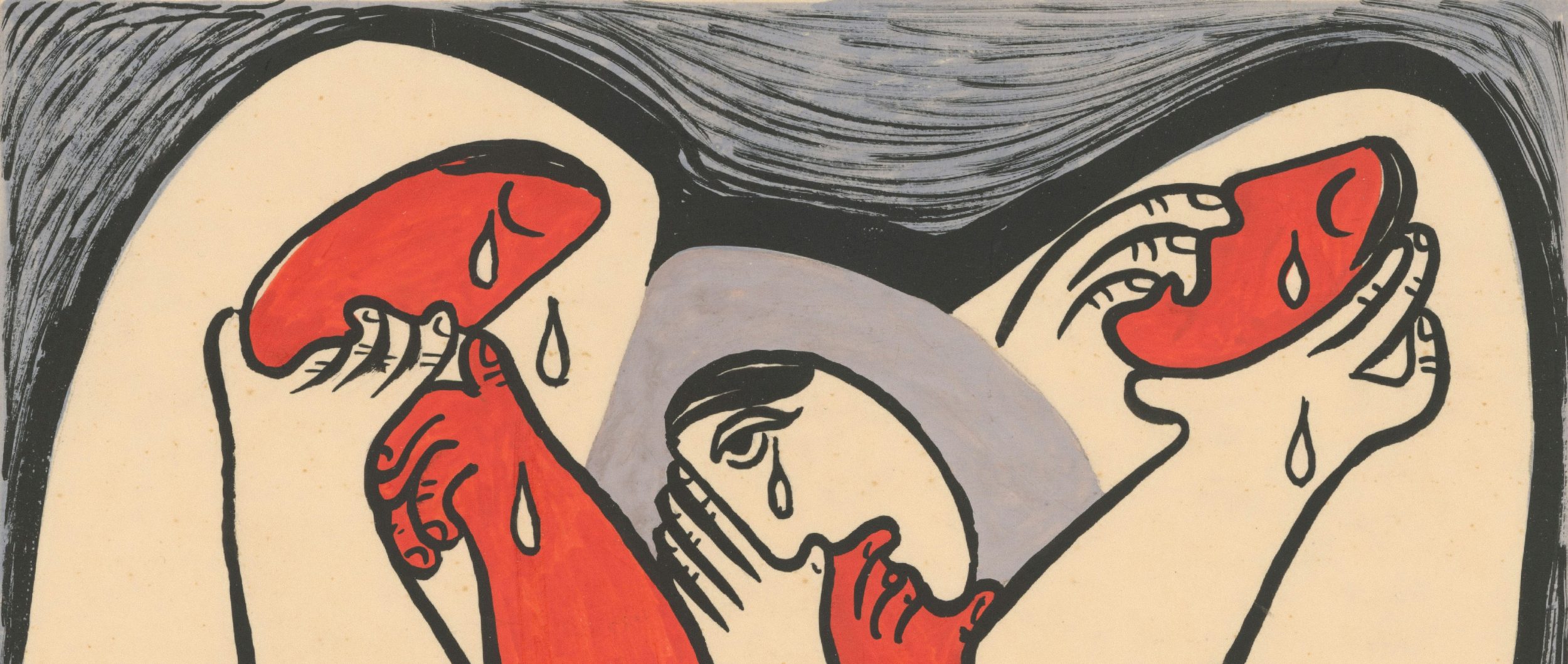On September 13, 2024, I sat on a steel cylinder stool and placed a plastic tray of food on a steel table in front of me in the mess hall of New York’s Green Haven Correctional Facility. I had arrived there the evening before, transferred from Sullivan Correctional Facility, about seventy miles west of Green Haven. JH, a man I had known from other facilities over the past nineteen years of my incarceration, sat across from me giving me the skinny on the joint. His taller-than-average frame shifted as he surveilled the area, giving an occasional nod.
“It’s bad here, bro, you’ll see,” he said, tapping out the syllables with his middle finger. “Nothing works here. Nothing.”
When his housing unit was called to leave, J double-tapped his plastic spork on the table, a greeting left over from when incarcerated people were not allowed to speak. He walked out. His tray remained next to mine. The food had been left untouched in commemoration of the Attica massacre on September 13, 1971. JH’s fasting honored those who had fallen during the Attica uprising so that people incarcerated in New York could have privileges like commissary, recreation, programming, and the ability to speak out loud to one another. For decades we have observed this day as a reminder of how bad things could be and that solidarity had created change.
Today, most incarcerated people do not recognize this date and seem to be in danger of forgetting that the privileges we enjoy daily came out of what happened on that day fifty-three years ago.
In 2007, as a newbie, I sat with a tray of food in Clinton Correctional Facility’s mess hall. “Don’t eat,” someone said. “It’s Attica Day.” I didn’t know what that meant, but the atmosphere—no one was eating, most were not talking and had their hands folded, staring straight ahead—created a powerful persuasion to comply.
Later that day, JM, who had come to prison a little over a decade after the uprising, shared some food with me and taught me about Attica Day. I leaned on his cell bars in the cellblock. His eyes were serious although his tone was playful as he explained that eating in the mess hall on that day could end your life. “When I came up, people would get stabbed for eating on Attica Day,” he added between bites. “It’s not that bad now, but some people still take it serious. Keep a toolkit,” he advised, “jars of peanut butter and jelly in your cell in case of a facility lockdown or Attica Day.”
Seventeen years later, all the men around me at Green Haven were eating and laughing heartily. Was no one taking Attica Day seriously anymore? Hands folded, I sat quietly without a word, staring into faces a generation younger than mine. Didn’t they know about Attica?
More from our decarceral brainstorm
Inquest, finalist for the 2025 National Magazine Award for General Excellence, brings you insights from the people working to create a world without mass incarceration.
Sign up for our newsletter to get the latest in your inbox every Saturday.
Newsletter
The fallout after the 1971 Attica uprising was considerable. The Weather Underground, a group of left-wing militants, set off a bomb at the New York Department of Corrections offices. Under political and public pressure, Governor Nelson Rockefeller, who had ordered the massacre in the first place, responded to it by creating the New York State Special Commission on Attica, which found there was plenty of official blame to go around.
Ultimately, the events at Attica resulted in a number of improvements for prisoners, among them better access to basics such as soap, showers, medical care, and family visits, as well as an inmate grievance process, higher education options, and greater religious freedom.
The guys surrounding me at Green Haven didn’t seem to know or care. As the population had changed, so had general awareness of Attica and its consequences. New York’s prison population is half what it was almost a decade ago, which is itself a good thing. But this reduction in population has taken place against a backdrop of prison closures and expense-cutting. Justified in the name of making better use of taxpayer money, it has left little funding to address the state’s crumbling carceral infrastructure and chronic disinvestment in incarcerated people’s health and welfare. Fewer prisons are not seen by bureaucrats as a sociological good but rather as an administrative liability. Add to this that state prisons are perpetually understaffed, in part due to lack of interest in corrections officer careers—a job that can include sixteen-hour workdays, restricted cell phone access (all communications devices are dangerous contraband on the inside), poor pay, social segregation (candidates who are related to people who have been convicted of a crime may be removed from consideration), and the ever-present threat of violence.
That is how I ended up being moved from Sullivan, my residence for eleven months, when it was marked for closure in 2024 by Governor Kathy Hochul. When I got to Green Haven, the impact of short staffing was immediately conspicuous: decreased access to recreation, programming, and commissary. It was reminiscent of a prison environment prior to the Attica uprising—conditions that convict messiahs had suffered crucifixion to deliver us from.
When I arrived at Green Haven, the chronic understaffing meant that our opportunities to be out of our cells were extremely limited. The limited amount of time we were permitted in the yard each day was the only time we were let out of our cell, besides to eat meals or in the rare event that someone had a medical or counselor callout.
During this yard time, I would have to make a choice. I could exercise or connect with a loved one over the phone. Whichever I chose, it had to be done within an hour. The rest of my day would be spent in a cell. It was difficult to find constructive ways to use my time and impossible to earn the meager 10 to 55 cents an hour I could receive from program participation. As far as I could tell, there weren’t any programs. So, I wrote to the programming committee to ask what was going on. When they eventually responded, I learned that most therapeutic, educational, and work programs had been suspended, to the point that there was basically nothing left.
Luckily, I was receiving financial support from my loved one, so I could still shop at the commissary—which, given how horrible prison food and medical care is, is often the only source of nutritious food and medicines. Unluckily, the commissary was fantastically disorganized, and items were frequently sold out without notice. Worse, no one knew when commissary would even take place. It was a guessing game. Instead of once every two weeks—the frequency stated in prison policy—it was usually more like three weeks, the exact day a mystery. Once I requested soap and bananas on my buy sheet. I showed up at the buy window only to learn they had run out of both, and I was not allowed to choose substitute items. I walked away from the window distressed, wondering when I would be able to purchase soap again or eat any fruit. Maybe next month, I thought.
We were starved for food and human interaction. It was most evident when chow was called. The sound of each cell as it opened was like a shotgun chambering a shell. Men made a dash out to the hallways. Once in the mess hall, loud conversations began. Prison conditions and New York’s 2021 Humane Alternatives to Long-Term Solitary Confinement (HALT) Act were the primary topics of discussion. The HALT Act had sought to end the use of solitary confinement as a routine form of prison discipline. The act curtailed long-term solitary confinement as well as forbade its use even short term for individuals who were pre-hearing (prior to a guilty disposition for violating a prison rule) or who’d been found to have committed minor infractions against prison discipline.
“You know that this shit is about the HALT bill,” FJ said. “Right after that they started doing all the dumb shit because they can’t just lock us in our cells.”
In spirit FJ may have been right, but in practice the guards had already found a way to circumvent the HALT Act: with short-staffing, they had found a way to kill the flock with one stone. Short-staffing has become the most effective and encompassing trope, greater than any disciplinary action could ever have been.
Then it got worse. On December 9, 2024, Robert Brooks was savagely beaten by corrections staff at New York’s Marcy Correctional Facility while health-care workers watched. He died of his injuries the following day. The video footage was made available to the public by Attorney General Leticia James. The brutality experienced by incarcerated people was now on display for the world to witness.
In February 2025, after the governor called for guards to be held accountable for killing Brooks, thousands of corrections staff walked off the job, commencing an illegal strike. The strike was ostensibly a protest of the HALT Act preventing them from using solitary confinement however they wished, and rather obviously a response to being held even minimally accountable for the well-being of the incarcerated people in their care. Facilities fell into immediate dysfunction. Incarcerated people were locked in their cells without means to carry out basic human functions or access medical care. At least nine incarcerated people died during the strike, from a mix of medical neglect, violence, and despair.
The toolkit of peanut butter and jelly that JM had told me to always keep helped some, but this was worse than a lockdown. This was like Attica. Heartlessly, the people in charge of our care left us in dire straits, confined, confused, and helpless.
Prison conditions after the strike have worsened. Most prisons are so short-staffed that the National Guard continues to be necessary to maintain basic operations. And we continue to live with the indefinite suspension of recreation, programs, commissary, access to visitation, and programs that strengthen familial bonds, such as the Family Reunion Program and Family Day. Meanwhile, illegal strikers have returned to work after receiving concessions to each of their demands. Yet, from the perspective of incarcerated people, the near-solitary-confinement-like conditions that we experienced during the strike have not ended. I often watch men returning to their cells after a meal or recreation, in zigzag movements scurrying from cell to cell, searching for something—a book, a snack, drugs—in preparation for lengthy lock-ins. The shotgun booms, the sound of prison bars slamming shut. And each of us is alone in our cells, once again.
One can’t help but think that this is not how taxpayers expect the state to use their dollars. The commissioner of New York corrections, Daniel Martuscello, has expressed that warehousing people is not optimal to the goal of rehabilitation, yet that is exactly how low the system has fallen. Surely this is not what those who sacrificed their lives during the Attica uprising envisioned. Those who led the Attica uprising wanted humane treatment. Their bravery resulted in meaningful improvements to prison regulations, which gave us access to recreation, programs, commissary, visitation, showers, and more. Those gains have largely been eroded. We want them back.
We must remember Attica again. It is important we recognize what we were given and celebrate the sacrifices that were made. Hopefully, this year, as we endure conditions that recall what people suffered before Attica, we will find a reinvigorated appreciation of the dead, of what is being lost. JH and I have never forgotten Attica Day. We will never forget.
Image: Crying Women (detail) by Mikuláš Galanda, Slovak National Gallery. Public domain.

